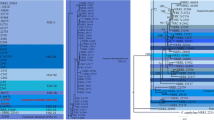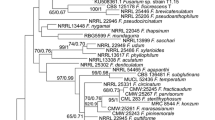Abstract
A new species ofFusarium, F. nisikadoi, isolated fromPhyllostachys nigra var.henonis (bamboo) andTriticum aestivum (wheat) in Japan, is described, illustrated and discussed. This species is differentiated from other known species of the genus by the following characteristics: whitish colony color, long zigzag-like chains of 0–3(-5)-septate clavate conidia, intermixed with pyriform conidia, produced mostly from monophialides and rarely from polyphialides in the aerial mycelium, very long and slender sporodochial conidia, and no chlamydospores. The long chains of septate conidia are known only in this species of the genusFusarium. The conidiophores on the aerial mycelium sometimes proliferate sympodially. The species is tentatively placed in the form-sectionLiseola.
Similar content being viewed by others
Literature cited
Burgess, L. W. and Trimboli, D. 1986. Characterization and distribution ofFusarium nygamai, sp. nov. Mycologia78: 223–229.
Gerlach, W. and Nirenberg, H. I. 1982. The genusFusarium-a pictorial atlas. Mitt. Biol. Bundesanst. Land- u. Forstwirtsch. Berlin-Dahlem209: 1–406.
Kornerup, A. and Wanscher, J. H. 1978. Methuen handbook of colour, 3rd ed. Eyre Methuen, London.
Kuhlman, E. G. 1982. Varieties ofGibberella fujikuroi with anamorphs inFusarium sectionLiseola. Mycologia74: 759–768.
Kwasna, H., Chelkowski, J. and Zajkowski, P. 1991. Grzyby (Mycota), tom XXII. Sierpik (Fusarium). Polska Akademia Nauk, Flora Polska, Warszawa.
Leslie, J. F. 1991. Mating populations inGibberella fujikuroi (Fusarium SectionLiseola). Phytopathology81: 1058–1060.
Leslie, J. F. 1995.Gibberella fujikuroi: available populations and variable traits. Can. J. Bot.73 (Suppl. 1): S282-S291.
Marasas, W. F. O., Nelson, P. E. and Toussoun, T. A. 1985.Fusarium dlamini, a new species from southern Africa. Mycologia77: 971–975.
Marasas, W. F. O., Rabie, C. J., Lubben, A., Nelson, P. E., Toussoun, T. A. and Wyk, P. S. van. 1987.Fusarium napiforme, a new species from millet and sorghum in southern Africa. Mycologia79: 910–914.
Marasas, W. F. O., Rabie, C. J., Lubben, A., Nelson, P. E., Toussoun, T. A. and Wyk, P. S. van. 1988.Fusarium nygamai from millet in southern Africa. Mycologia80: 263–266.
Nelson, P. E., Toussoun, T. A. and Burgess, L. W. 1987. Characterization ofFusarium beomiforme sp. nov. Mycologia79: 884–889.
Nelson, P. E., Toussoun, T. A. and Marasas, W. F. O. 1983.Fusarium species: an illustrated manual for identification. Pennsylvania State Univ. Press, University Park.
Nirenberg, H. I. 1976. Untersuchungen über die morphologische und biologische Differenzierung in derFusarium-SektionLiseola. Mitt. Biol. Bundesanst. Land- u. Forstwirtsch. Berlin-Dahlem169: 1–117.
Nirenberg, H. I. 1989. Identification of fusaria occurring in Europe on cereals and potatoes. In:Fusarium: Mycotoxins, taxonomy and pathogenicity, (ed. by Chelkowski, J.), pp. 179–193. Elsvier, Amsterdam.
Nirenberg, H. I. 1990. Recent advances in the taxonomy ofFusarium. Stud. Mycol.32: 91–101.
O'Donnell, K. and Cigelnik, E. 1997. Two divergent intragenomic rDNA ITS2 types within a monophyletic lineage of the fungusFusarium are nonorthologous. Mol. Phylo. Evol.7: 103–116.
O'Donnell, K., Cigelnik, E. and Nirenberg, H. I. 1998. Molecular systematics and phylogeography of theGibberella fujikuroi species complex ofFusarium. Mycologia. (In press.)
Peterson, S. W. and Logrieco, A. 1991. Ribosomal RNA sequence variation among interfertile strains of someGibberella species. Mycologia83: 397–402.
Rheeder, J. P., Marasas, W. F. O. and Nelson, P. E. 1996.Fusarium globosum, a new species from corn in southern Africa. Mycologia88: 509–513.
Snyder, W. C. and Hansen, H. M. 1940. The species concept inFusarium. Am. J. Bot.27: 64–67.
Snyder, W. C. and Hansen, H. M. 1941. The species concept inFusarium with reference to sectionMartiella. Amer. J. Bot.28: 738–742.
Snyder, W. C. and Hansen, H. M. 1945. The species concept inFusarium with reference toDiscolor and other sections. Amer. J. Bot.32: 657–666.
Summerell, B. A., Rugg, C. A. and Burgess, L. W. 1995. Characterization ofFusarium babinda sp. nov. Mycol. Res.99: 1345–1348.
Voigt, K., Schleier, S. and Brückner, B. 1995. Genetic variability inGibberella fujikuroi and some related species of the genusFusarium based on random amplification of polymorphic DNA (RAPD). Curr. Genet.27: 528–535.
Waalwijk, C., Baayen, R. P., Koning, J. R. A. de and Gams, W. 1996a. Ribosomal DNA analyses challenge the status ofFusarium sectionLiseola andElegans. Sydowia48: 90–104.
Waalwijk, C., Koning, J. R. A. de, Baayen, R. P. and Gams, W. 1996b. Discordant groupings ofFusarium spp. from sectionsElegans, Liseola andDlaminia based on ribosomal ITS1 and ITS2 sequences. Mycologia88: 361–368.
Wollenweber, H. W. and Reinking, O. A. 1935. Die Fusarien, ihre Beschreibung, Schadwirkung und Bekämpfung. Paul Parey, Berlin.
Author information
Authors and Affiliations
About this article
Cite this article
Nirenberg, H.I., Aoki, T. Fusarium nisikadoi, a new species from Japan. Mycoscience 38, 329–333 (1997). https://doi.org/10.1007/BF02464091
Accepted:
Issue Date:
DOI: https://doi.org/10.1007/BF02464091




